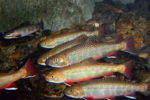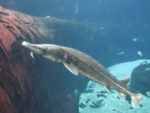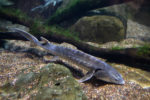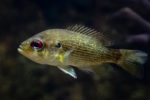Tracking native species
Since invasive species often contribute to the decline of important native fish species, our new grant expands our monitoring program to include threatened, endangered, and declining native fish species.
According to the Federal Endangered Species Act of 1973, two categories of declining species of plants and animals need protection: endangered species and threatened species. Endangered species are defined as “any species that is in danger of extinction throughout all or a significant portion of its range”, while a threatened species is defined as “any species that is likely to become an endangered species within the foreseeable future throughout all or a significant portion of its range”. Simply put, endangered species are at the edge of extinction now, and threatened species are likely to be at the edge of extinction in the near future. Declining species not yet characterized as threatened or endangered can show significant decreases in population, and will benefit from monitoring information to help understand population levels.
Species we’re tracking
Declining New York native species
Deep water cisco, also called Lake Herring (Coregonus artedii)

Ciscoes are freshwater schooling fish that are predominantly found in waters below 18°C (~65°F). These cold-water fish breed once a year, spawning in shallow coastal waters in the winter and returning to deeper waters during the spring. Cisco eggs develop slowly, hatching in the spring as the ice starts to thaw. Juveniles usually live in shallow bays for their first month, and mature within 1 to 4 years.
Ciscoes play an important role in the ecosystem. They feed predominantly on zooplankton and insect larvae and are a primary food for other economically important fish species like lake trout, yellow perch, walleye, and northern pike. In the 1940s, ciscoes were one of the most commercially important fish in the Great Lakes, where fisheries produced an average of 19 million pounds annually. However, the combined pressures of over-fishing, competition by invasive species like rainbow trout and alewives, and pollution have caused a significantly declining population.
Once abundant in all five Great Lakes, ciscoes are now common only in Lake Superior. Currently one of the greatest risks to ciscoes in the Great Lakes is the increasing level of nutrients being added to the lakes each year, which results in a decrease in the amount of oxygen in the water. Ciscoes are sensitive to changes in temperature and levels of dissolved oxygen. Being forced to move into shallower, warmer parts of the water column where higher temperatures during the summer months can cause large die-offs in cisco populations.
In New York, ciscoes are native to ten watersheds in Great Lakes drainage, including the Finger Lakes, lower elevations of the Adirondacks, and Chautauqua Lake. However, populations have declined in the westernmost watersheds and in lower elevation lakes, including Lake Erie. Re-establishing Cisco in the lower Great Lakes would help improve connections in the food web. Additional information on location and abundance of native populations will aid efforts to protect and restore this important native species.
Map of cisco range in New York pre/post 1976-1977
American eel (Anguilla rostrate)

American eels are the only freshwater eel native to North America. American eels hatch in the Sargasso Sea in North Atlantic. Larvae drift with the Gulf Stream, reaching the US Atlantic coast about a year later. American eels undergo several distinct morphological stages as they mature. Depending on the environment, they can take up to 40 years to reach sexual maturity, at which time they return to the Sargasso Sea where each female lays 20 -30 million eggs.
Although the American eel remains widely distributed throughout much of its historical range, the population has decreased significantly over the last several decades, a result of the combined effects of habitat destruction, dam construction, water pollution, parasites, and overfishing, along with a huge increase in demand by Asian food markets following large decreases in the native Asian eel populations. Although the U.S. Fish and Wildlife Service has not yet provided endangered species protection to the American eel, populations are declining, and according to the International Union for Conservation of Nature (IUCN), the American eel is at very high risk of extinction.
Conservation of the American eel is important for many reasons. American eels are an ecologically important species, playing various roles as prey, predator, and host species that help maintain ecosystem balance. In New York, the American eel is native to 17 of 18 watersheds. It was introduced to Lake Erie but the population was not sustained. American eel numbers have been greatly reduced throughout the watersheds of the Great Lakes. It has been completely eliminated from the Allegheny, and has declined to levels below detection in the Chemung and Susquehanna.
Although conservation efforts are now underway, much more will need to be done to restore this important species to healthy, sustainable levels. Efforts to protect and restore this important native species will benefit from additional information on current locations and abundance of native populations.
Map of American eel range in New York pre/post 1976
Brook trout (Salvelinus fontinalis)

Brook trout are popular small game fish generally weighing two pounds or less and seldom living more than five years. They require clean high-quality cold water (below 72 degrees Fahrenheit) to survive and depend on clean gravel areas for spawning. Once widely distributed, brook trout are now most commonly found in small streams and the headwaters of larger streams in mountainous areas. Brook trout are so sensitive to environmental conditions that they are considered an environmental indicator species. A large number of brook trout generally indicates a relatively healthy aquatic environment while a decline in the brook trout population often indicates a deteriorating habitat and decreased water quality. Brook trout are native to all 18 New York watersheds and have been introduced to additional areas throughout the state where they are not native. However, intact stream populations of brook trout now exist in only 5% of sub-watersheds, and the vast majority of large rivers that were historically home to thriving brook trout populations no longer support self-reproducing populations.
Although not listed under the Endangered Species Act, the brook trout have suffered decline due to a combination of factors. Brook trout evolved in waters where there were few other fish species competing for resources. Brook trout do not compete well when non-native fish like yellow perch, bass, golden shiner, and various baitfish (small fish used as bait to attract larger fish, often game fish) are introduced into their waters. In the presence of non-native fish, brook trout populations generally experience a serious decline. As a result, the use of baitfish is prohibited in many brook trout ponds and it is illegal in New York to introduce any fish into waters they did not come from. Brook trout are also particularly sensitive to the effects of acid rain, especially in areas low in limestone that cannot naturally buffer increases in acidity. As a result of acid rain coupled with illegal fishing, in some areas of the Adirondacks, only ~3% of the waters that previously supported brook trout still maintain a viable population. To help counter this problem, New York State has stringent acid rain control requirements and is working to support reductions in power plant emissions outside the state.
An active brook trout restoration program has been established in the Adirondack Park. To secure the survival of the species in this area, ponds are selectively treated with lime each winter to decrease acidity levels, and competitive non-native fish populations are eliminated. When acidity levels suitable for fish survival are reached and competing fish species have been eradicated, ponds are restocked with brook trout.
Map of brook trout range in NY pre/post 1976
Threatened and endangered New York native species
Sturgeon
Three types of sturgeon are found in New York waters, the Atlantic sturgeon (Acipenser oxyrinchus oxyrinchus), the Lake Sturgeon (Acipenser fulvescens), and the Shortnose sturgeon (Acipenser brevirostrum). The FishTracker sturgeon primers detect all three species.
Atlantic sturgeon (Acipenser oxyrinchus oxyrinchus)

The Atlantic sturgeon is the biggest and longest-living of the sturgeons found in New York, with adults often reaching 6 to 8 feet or more in length and weighing over 100 pounds. Atlantic sturgeon are anadromous fish, which means that they are born in fresh water, but spend most of their lives in the ocean. Adults migrate from the salty ocean into rivers to lay their eggs in fresh water, sometimes traveling hundreds of miles to spawn, and then returning to the ocean when spawning is complete.
After hatching, young Atlantic sturgeon remain in the fresh water environment for several years before migrating to the ocean, where they live for several more years before reaching sexual maturity. When ready to spawn, each generation of Atlantic sturgeon briefly returns to fresh water to lay their eggs. Female sturgeon can lay up to 2 million eggs during a single spawning season, but females do not spawn every year.
Atlantic sturgeon are toothless bottom feeders, using a tubular mouth to suck up food including plants, invertebrates such as mollusks, worms, and crustaceans, as well as small bottom-dwelling fish. Atlantic sturgeon were once an abundant, commercially important fish in the Hudson river, especially prized for their meat, tough skins that were made into leather, and eggs (caviar). However, over the span of 100 years the catch of Atlantic sturgeon dropped from nearly 7 million pounds in1887 to only 400 pounds in 1989. As a result of this dramatic decrease, Atlantic sturgeon are now considered an endangered species in New York and are protected from fishing. The New York Department of Environmental Conservation, NOAA (National Oceanic and Atmospheric Administration) Fisheries and other groups are attempting to conserve and rebuild Atlantic sturgeon populations along the East Coast. However, the species still faces a number of threats including entanglement in fishing gear, bycatch (the unintentional capture of non- target species), dams and other barriers that impede habitat access, and being hit by boats.
Lake sturgeon (Acipenser fulvescens)

The lake sturgeon is New York’s largest fresh water fish, averaging between 3 to 5 feet in length and weighing up to 80 pounds. Lake sturgeon are bottom feeders, eating primarily insect larvae, worms, leeches, other invertebrates including snails and clams, and algae. Lake sturgeon can live up to 80 years or more, and take 4 to 23 years to reach sexual maturity. Once mature, a female can lay 200,000 to 800,000 eggs during a single season, but lake sturgeon only spawn every four to six years. Lake sturgeon lay their eggs from April to June in rapidly moving water, like rocky island shores and quickly moving gravel streams where, after being scattered by currents, the eggs stick to rocks and logs.
The lake sturgeon population underwent a precipitous decline in the 1900s. From 1879 – 1900 the commercial catch of lake sturgeon in the Great Lakes averaged over 4 million pounds. However, by 1929 the commercial harvest of lake sturgeon in Lake Michigan was only 2000 pounds, a result primarily of high demand for their eggs (caviar) and meat. More recently the lake sturgeon population has been further impacted by the construction of dams that cut off spawning and nursery areas; pollution and channelization (altering the course of a waterway to form straight channels) that caused degradation of habitat; and invasive aquatic species. Remnant populations of lake sturgeon are believed to currently exist in several waterways in New York, including the St. Lawrence River, Niagara River, Oswegatchie River, Grasse River, Lake Ontario, Lake Erie, Lake Champlain, Cayuga Lake, and in the Seneca and Cayuga canals. However, the lake sturgeon is currently listed as threatened by the American Fisheries Society since the population has not recovered from the losses that occurred in the 1900s.
To help protect and manage lake sturgeon populations, the New York State Department of Environmental Conservation (DEC) is researching lake sturgeon populations and attempting to reestablish lake sturgeon populations in some tributaries of Lake Ontario, the St. Lawrence River, the Oswegatchie River, Black Lake, the St. Regis River, Oneida Lake and Cayuga Lake.
Shortnose sturgeon (Acipenser brevirostrum)

The shortnose sturgeon is the smallest sturgeon found in New York waterways, averaging under 4 feet long and less than 14 pounds. Shortnose sturgeon are bottom feeders, primarily eating mollusks, worms, insects and crustaceans. Like other sturgeon, the shortnose sturgeon is a long-lived, slow maturing fish. Females take 6 to 17 years to become sexually mature, and can live nearly 70 years. Adult females can lay up to 200,000 eggs in one season, but only breed every 3 to 5 years.
In New York, the shortnose sturgeon is found only in the lower part of the Hudson River, from the southern tip of Manhattan to the Federal Dam at Troy. Shortnose sturgeon overwinter in the Hudson River and spawn in fresh water areas north of Coxsackie. The shortnose sturgeon population in New York was decimated as a result of over-fishing due to demand for its meat and caviar. In addition, during the 1800s and early 1900s tidal rivers like the Hudson were used as dumping grounds for pollutants, causing severe decreases in water oxygen levels that resulted in high die-offs of the once common shortnose sturgeon, along with many other fish species. Damming of the Hudson River, which cut off upriver spawning grounds, also contributed to the shortnose sturgeon decline.
Currently the shortnose sturgeon is listed as endangered by the National Marine Fisheries Service and is therefore protected by the Endangered Species Act. State and national agencies are working to re-establish the shortnose sturgeon population through research and strict regulations prohibiting fishing of this endangered species.
Common native species
Rock Bass (Ambloplites rupestris)

Rock Bass are found in streams and lakes throughout New York, generally in areas of clear water, abundant vegetation, and rocky or sandy areas. Rock bass average 6 to 8 inches in length but can grow to 10 to 12 inches long and weigh over 1 pound, feeding mostly on aquatic insects, crayfish, and other small fishes. Rock bass take 2 – 3 years to become sexually mature. Adult females lay 2,000 to 11,000 eggs between April and early June, after which the male guards the eggs and the newly hatched young for a brief time.
Rock bass are found in all New York watersheds but are not native to the Adirondacks or to the Atlantic slope watersheds, where they were introduced between 1889 and 1936 by the United States Fish Commission.
Given their population stability, rock bass are listed as a species of “least concern” by the International Union for Conservation of Nature and currently do not require monitoring or conservation management plans, although due to their status as a sport fish, their population is managed in some areas. Because of their abundance and widespread distribution, rock bass can be used for comparative purposes when analyzing results for declining, threatened, and endangered fish species.